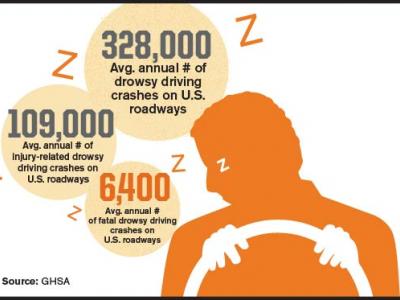GHSA PolicyClick here to view GHSA's Policy and Priorities on Drowsy Driving. |
Research shows that nearly 83.6 million sleep-deprived people are in the workplace, at school or driving on the road. A drowsy driver is a dangerous driver for a variety of reasons: Lack of sleep slows reaction time, impairs judgment and situational awareness, and increases lapses in attention and risk-taking – all skills necessary for safely operating a vehicle.
The National Highway Traffic Safety Administration (NHTSA) estimates that in 2017, 91,000 police-reported crashes involved drowsy drivers. These crashes led to an estimated 50,000 people injured and nearly 800 deaths. However, it is agreed that drowsy driving is significantly underreported. There were 684 fatalities involving a drowsy driver in 2021, up 8.2% from 632 deaths in 2020 (Overview of Motor Vehicle Traffic Crashes in 2021, NHTSA).
The National Road Safety Foundation
GHSA partners with the National Road Safety Foundation to support innovative state approaches that address the pressing issue of drowsy driving through a competitive grant program. Grantee efforts have included projects enhancing public awareness campaigns, law enforcement training, outreach to fatigue-prone demographics of drivers and more. Further information about this partnership is available here.
News tagged with Drowsy Driving
Related News
Featured Initiative
Drowsy Driving Prevention Grant: Georgia
In 2019, through a grant from the National Road Safety Foundation (NRSF), the Georgia Governor’s Office of Highway Safety (GOHS) participated in the Georgia National Fair by setting up a booth to raise awareness regarding drowsy driving.Read More



